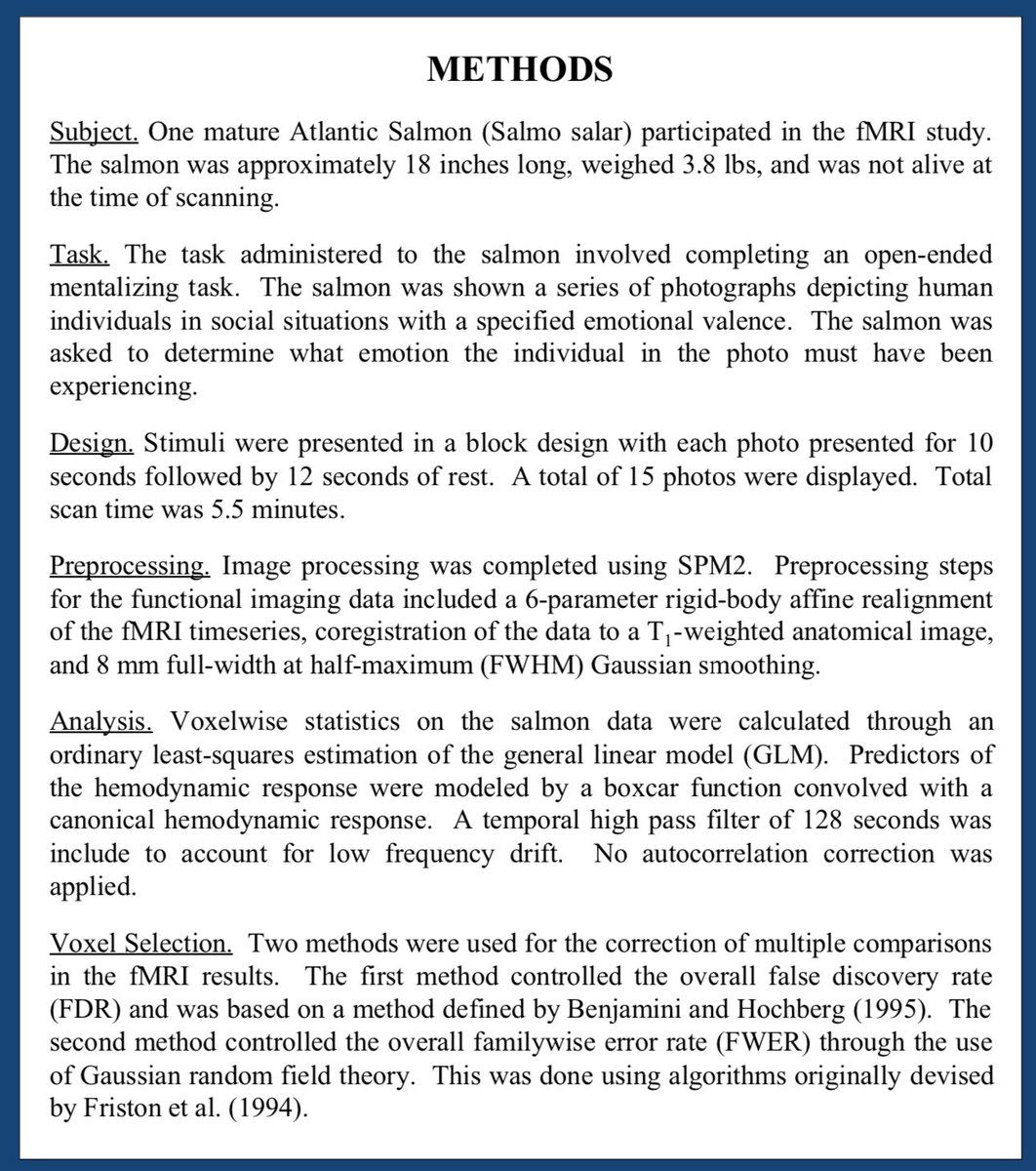-
1) In 2008 a salmon (yes the fish) was put through an MRI scanner. The salmon was shown a series of photographs of humans in social situations, and asked to determine the emotion of the person in the photo (yes, really).
- …in reply to @axbom
-
…in reply to @axbom
3) Without running through multiple comparisons correction (which isn't always done) one could conclude that that the salmon was in fact reacting to the photographs.
-
…in reply to @axbom
4) Here's another fact about that salmon though: it was dead and frozen at the time of the scan. The experiment was really just a test of the machine. After testing with a pumpkin and a Cornish game hen, they settled on the fish, which had several types of tissue.
-
…in reply to @axbom
5) As the story goes, the lead author of this study, Dr. Craig Bennett had headed into the store first thing in the morning and proclaimed: "I need a full length Atlantic Salmon. For science."
-
…in reply to @axbom
6) It was not until after a long while, when the another author of the study was running a seminar on how to properly analyze fMRI data, that the significance of the salmon data became a useful example. The salmon study was born.
-
…in reply to @axbom
7) If you do a lot of tests, at least some of them will come out positive, even if they are not real. These are called false positives, and they are something you really want to watch out for.
-
…in reply to @axbom
8) To be clear, the salmon study doesn't show that fMRI is bogus. It shows the huge importance of correcting your stats. There are good and bad ways of doing all science.
-
…in reply to @axbom
9) When the poster for this study was presented, between 25-40% of studies on fMRI being published were NOT using corrected comparisons. But by the time these authors won the Ignobel Prize, that number dropped to 10%. That salmon is a hero.
-
…in reply to @axbom
10) Reminder: when we see images with areas of the brain in bright colors, that’s not necessarily telling us that one part of the brain is active and the rest isn’t. They’re probability maps. They show the likelihood of activity happening in a given area, not proof of activity.
-
…in reply to @axbom
11) Colorful brain images have powerful persuasive powers. As does most stats. It's just generally good advice to understand what you're looking at.
-
…in reply to @axbom
12) Here's more info on when they won the IgNobel Prize: blogs.scientificamerican.com/scicurious-brain/ignobel-prize-in-neuroscience-the-dead-salmon-study/ And please also read this interview with two of the authors: it's brilliant: boingboing.net/2012/10/02/what-a-dead-fish-can-teach-you.html Craig Bennet is also on Twitter: prefrontal
-
…in reply to @axbom
13) Moral of the story: don't go fishing unless you' re prepared to not catch any fish. prefrontal.org/files/posters/Bennett-Salmon-2009.pdf
-
…in reply to @axbom
14) If you enjoyed this thread you may also appreciate my thread on the replication crisis: axbom/956829916548550656?s=21
- …in reply to @axbom
-
…in reply to @axbom
16) To everyone saying that scanning live salmon wouldn't work anyway, it has been done :) discovermagazine.com/mind/fmri-scanning-salmon-seriously
-
…in reply to @axbom
17) To be even more clear: fMRI does not measure activity in the brain. You'd need electrodes implanted in the brain to do that. It measures magnetic disruption in the brain, based on oxygenated and deoxygenated blood having different magnetic properties. Hence false positives.
-
…in reply to @axbom
18) "There's all kinds of noise that gets entered into the signal. It'll pick up your own heart beating. We once had a lightbulb going bad in the scanner suite that was introducing specific signal in our data set. You have to get enough data [...] to separate signal from noise."
-
…in reply to @axbom
19) "More than a couple papers have been sesationalistic. There have been comparisons of Republican and Democratic brains. That's ridiculous and it's a misuse of fMRI." Do read the interview with the authors if you didn't already. boingboing.net/2012/10/02/what-a-dead-fish-can-teach-you.html/amp?__twitter_impression=true

